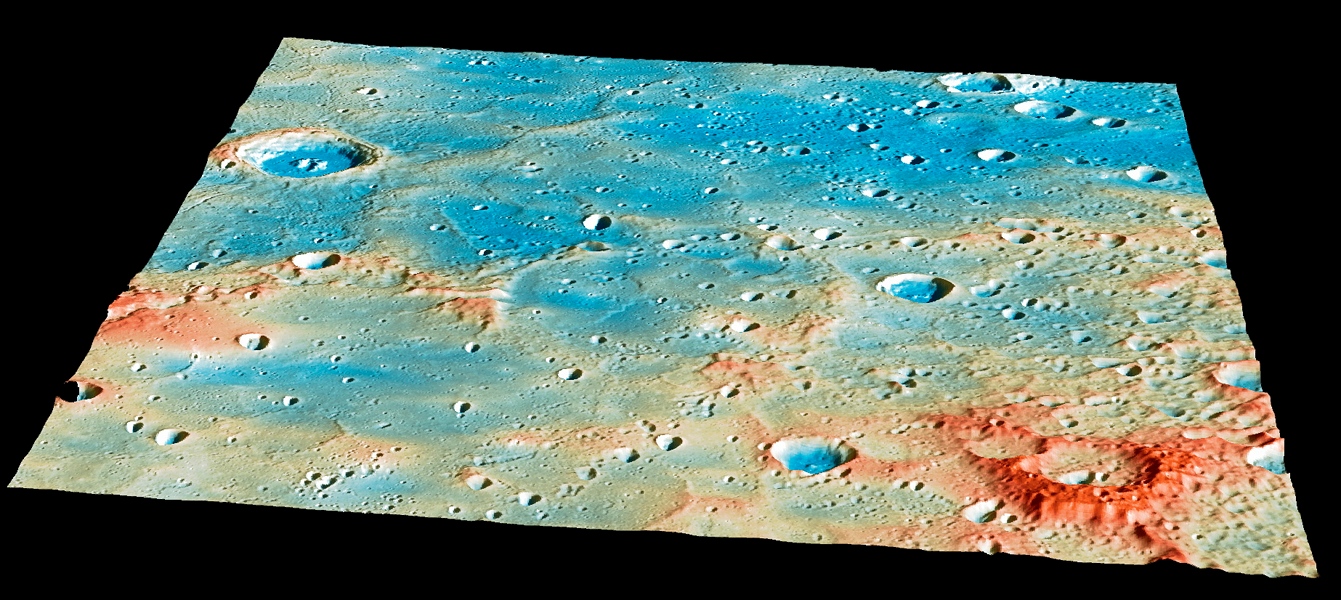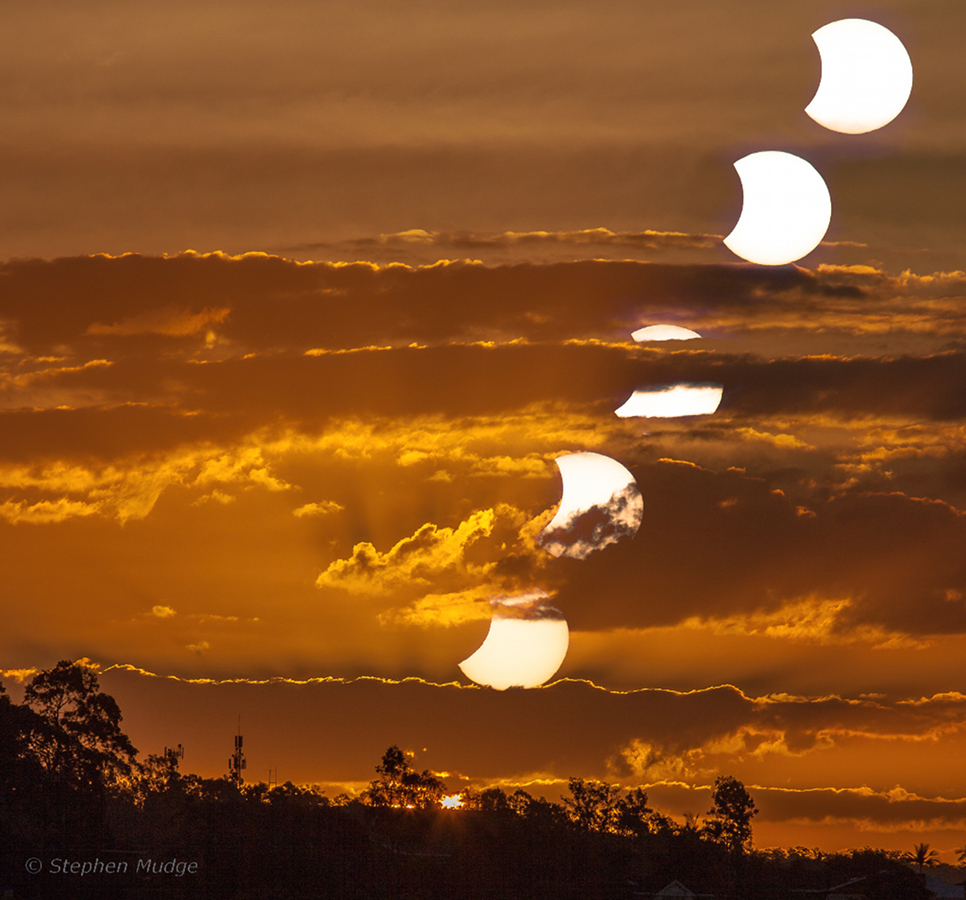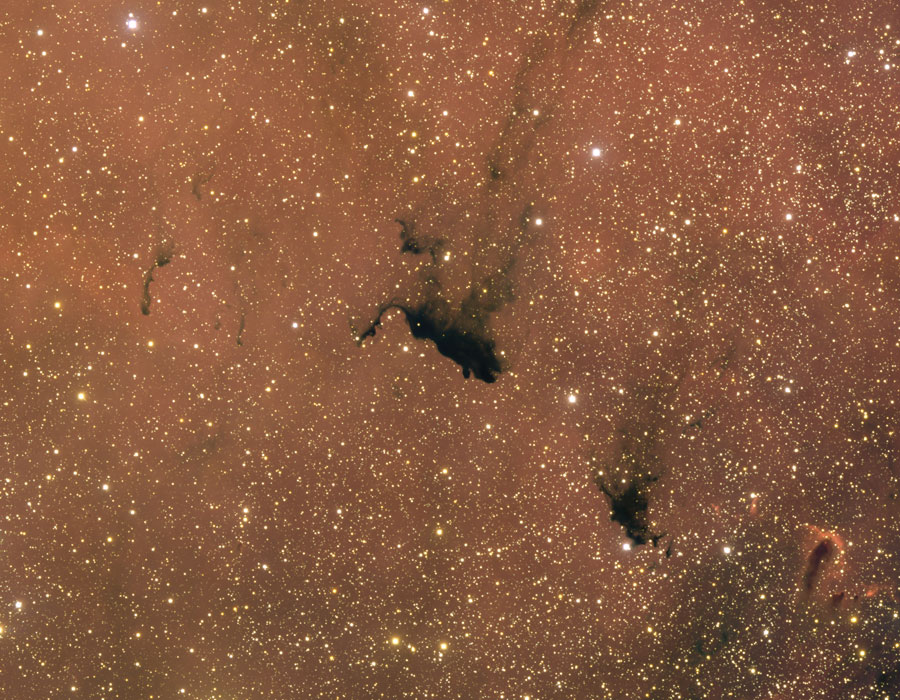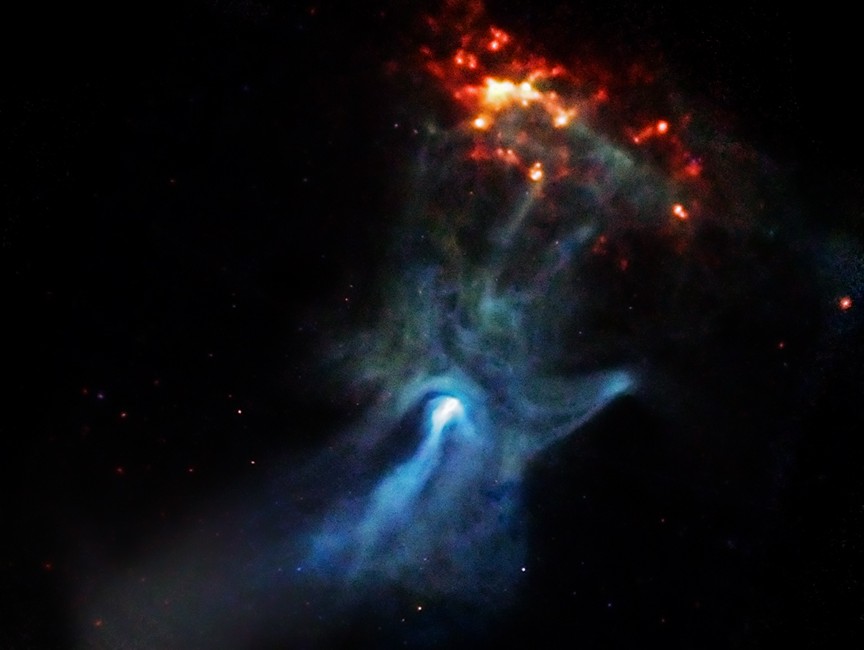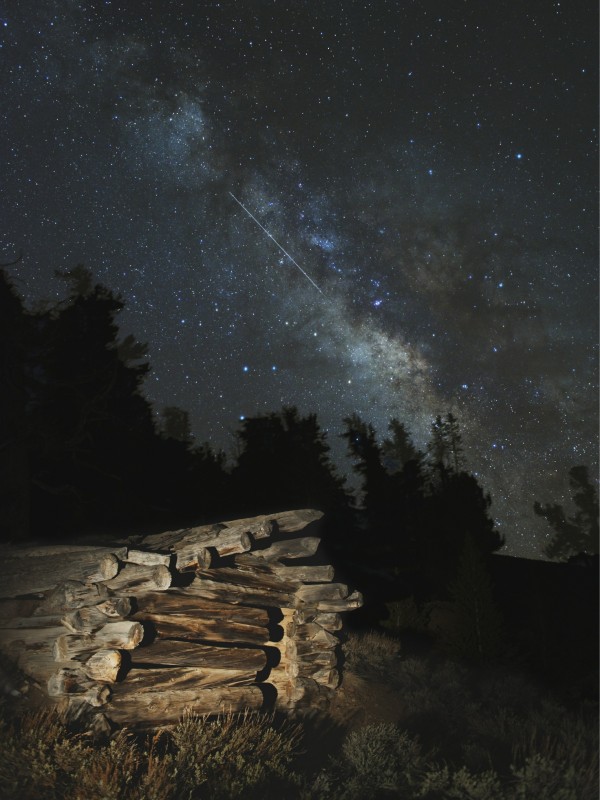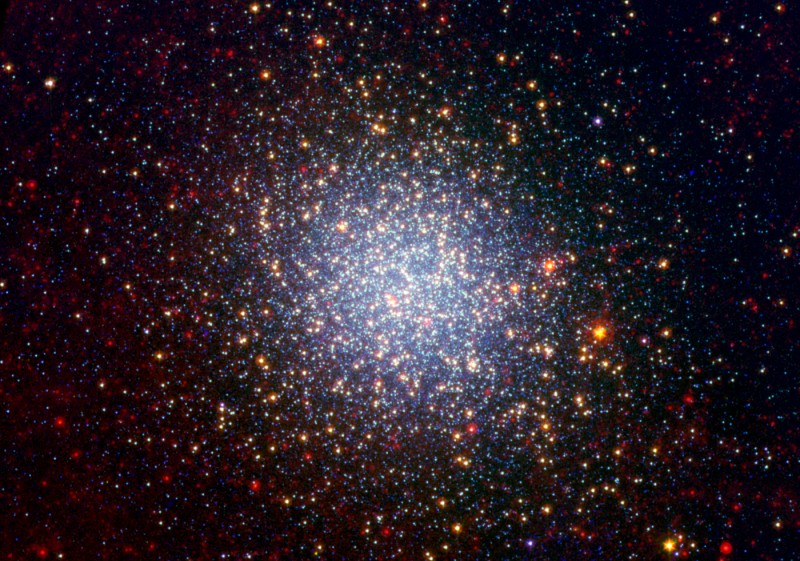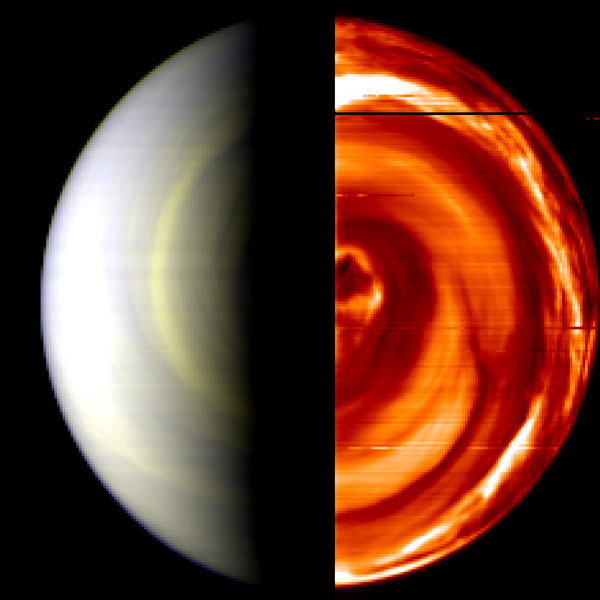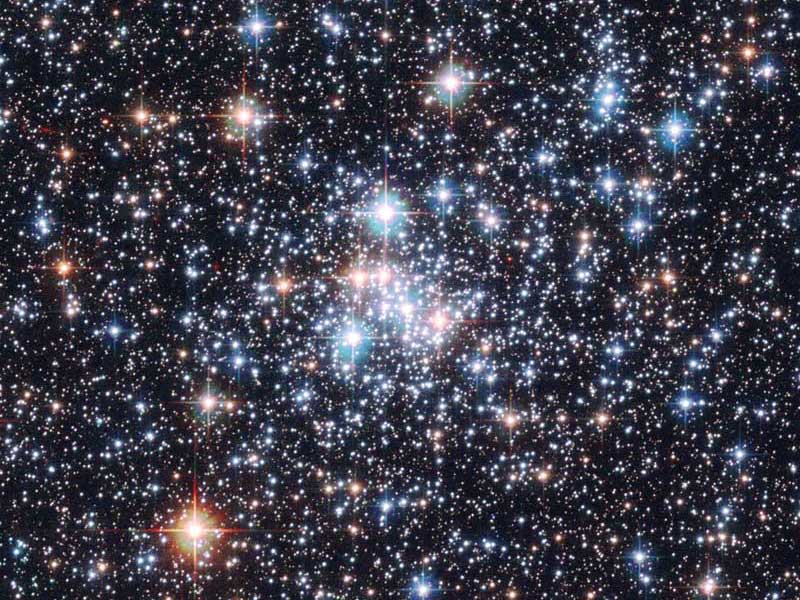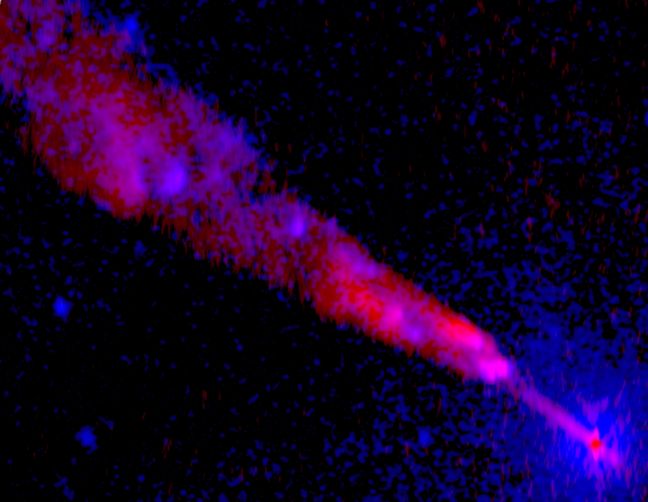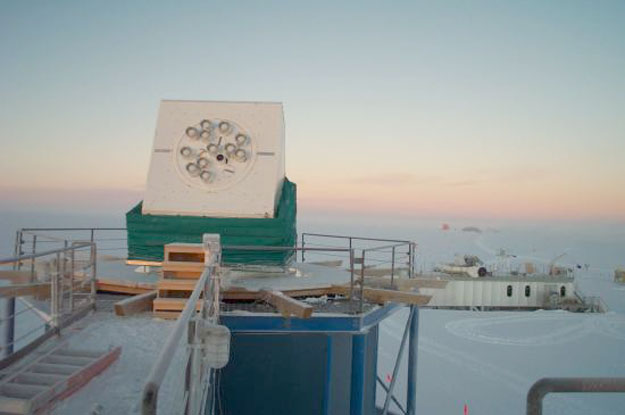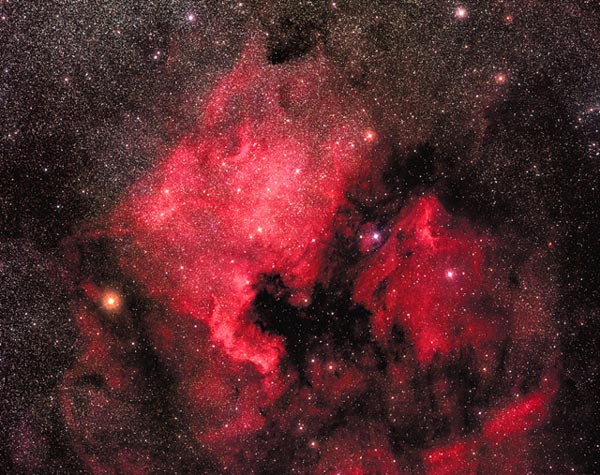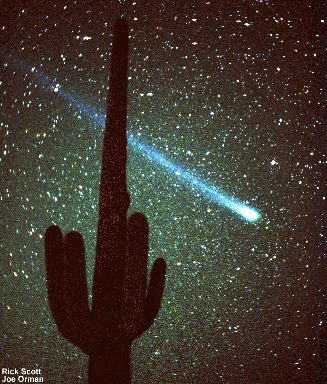| << Previous | Index | Next >> |
2015 The first to orbit Mercury, the MESSENGER spacecraft came to rest on this region of Mercury's surface yesterday. Constructed from MESSENGER image and laser altimeter data, the scene looks north over the northeastern rim of the broad, lava filled Shakespeare basin. The large, 48 kilometer (30 mile) wide crater Janacek is near the upper left edge. Terrain height is color coded with red regions about 3 kilometers above blue ones. MESSENGER'S final orbit was predicted to end near the center, with the spacecraft impacting the surface at nearly 4 kilometers per second (over 8,700 miles per hour) and creating a new crater about 16 meters (52 feet) in diameter. The impact on the far side of Mercury was not observed by telescopes, but confirmed when no signal was detected from the spacecraft given time to emerge from behind the planet. Launched in 2004, the MErcury Surface, Space ENvironment, GEochemisty and Ranging spacecraft completed over 4,000 orbits after reaching the Solar System's innermost planet in 2011.
2014 In skies over Brisbane at the southeastern corner of Queensland, Australia, Planet Earth, the Sun and New Moon set together on April 29. There the celestial line-up, the first solar eclipse of 2014, was seen as a partial solar eclipse. This dramatic composite is a digital stack of images taken about 5 minutes apart with telephoto lens and solar filter. It follows the eclipse in progress, approaching a western horizon where crepuscular rays from cloud banks in silhouette joined the silhouetted Moon. From Brisbane, the maximum eclipse phase with the Moon covering about 25% of the Sun occurred just after sunset. Only from a remote spot on the continent of Antarctica was it even possible to see the eclipse in its brief annular phase, the entire dark lunar disk surrounded by a thin, bright ring of fire.
2013
2012
Illustrations Credit & Copyright: Jorge Cham, PHD Comics
2011 It may look to some like a duck, but it lays stars instead of eggs. In the center of the above image lies Barnard 163, a nebula of molecular gas and dust so thick that visible light can't shine through it. With a wing span measured in light years, Barnard 163's insides are surely colder than its exterior, allowing conditions where gas can clump and eventually form stars. Barnard 163 lies about 3,000 light years from Earth toward the constellation of Cepheus the King. The red glow in the background results from IC 1396, a large emission nebula that houses the Elephant's Trunk Nebula. Finding Barnard 163 in an image of its greater emission nebula IC 1396 can be a challenge, but it's possible.
2010 As far as pulsars go, PSR B1509-58 appears young. Light from the supernova explosion that gave birth to it would have first reached Earth some 1,700 years ago. The magnetized, 20 kilometer-diameter neutron star spins 7 times per second, a cosmic dynamo that powers a wind of charged particles. The energetic wind creates the surrounding nebula's X-ray glow in this tantalizing image from the Chandra X-ray Observatory. Low energy X-rays are in red, medium energies in green, and high energies in blue. The pulsar itself is in the bright central region. Remarkably, the nebula's tantalizing, complicated structure resembles a hand. PSR B1509-58 is about 17,000 light-years away in the southern constellation Circinus. At that distance the Chandra image spans 100 light-years.
2009 On April 22nd, the Lyrid Meteor Shower visited planet Earth's sky, an annual shower produced as the Earth plows through dust from the tail of comet Thatcher. Usually Lyrid meteor watchers see only a drizzle. Just a few meteors per hour stream away from the shower's radiant point near bright star Vega in the constellation Lyra. But photographer Tony Rowell still managed to catch one bright Lyrid meteor. Recorded in early morning hours, his well-composed image looks toward the south from White Mountains of eastern California, USA. During the time exposure, he briefly illuminated an old mining cabin in the region's Ancient Bristlecone Pine Forest in the foreground. The rich starfields and dust clouds of our own Milky Way galaxy stretch across the background, along the meteor's glowing trail.
2008 Globular star cluster Omega Centauri is some 15,000 light-years away and 150 light-years in diameter. Packed with about 10 million stars, Omega Cen is the largest of 200 or so known globular clusters that roam the halo of our Milky Way galaxy. This intriguing color picture combines a visible light image of the cluster in blue hues with infrared image data from the Spitzer Space Telescope. The Spitzer data includes images in two infrared bands, one shown in green and one in red. Both infrared bands are sensitive to light from the cool, giant stars in the cluster. Adding the red and green colors together creates yellow, showing off the cluster's giant stars as yellow spots. Of course, red spots also indicate cool, giant stars in the image, but some of the red spots are even more distant background galaxies. Also known simply as Red Giant Stars, they represent a stage in the life-cycle of stars more evolved than our own Sun, a stage the Sun will reach in about 5 billion years. Dust grains formed in the atmospheres of cool, giant stars are ultimately involved in the formation of other stars and planets.
2007 What's happening over the South Pole of Venus? To find out, scientists sent the robot Venus Express spacecraft now orbiting Venus directly over the lower spin axis of Earth's overheated twin. Venus Express confirmed there a spectacular massive swirling storm system with similarities to the vortex recently imaged over Saturn's South Pole. The above composite image in infrared light features Venus' daytime side on the left, shining primarily by reflected sunlight, and nighttime side on the right, shining primarily by thermal light. A Venusian polar vortex is visible as the small circular feature near the center of the thermal infrared image pictured on the right. Close inspection of other South Pole images unexpectedly showed a second vortex, meaning that the unusual swirling clouds are like an Earth-hurricane that has two eyes. Why a double vortex has formed is now a topic of research. The above image was taken last year, and more recent images from Venus Express are being processed that have as much as 100 times more detail.
2006 Jewels don't shine this bright -- only stars do. Like gems in a jewel box, though, the stars of open cluster NGC 290 glitter in a beautiful display of brightness and color. The photogenic cluster, pictured above, was captured recently by the orbiting Hubble Space Telescope. Open clusters of stars are younger, contain few stars, and contain a much higher fraction of blue stars than do globular clusters of stars. NGC 290 lies about 200,000 light-years distant in a neighboring galaxy called the Small Cloud of Magellan (SMC). The open cluster contains hundreds of stars and spans about 65 light years across. NGC 290 and other open clusters are good laboratories for studying how stars of different masses evolve, since all the open cluster's stars were born at about the same time.
2005 Why isn't this ant a big sphere? Planetary nebula Mz3 is being cast off by a star similar to our Sun that is, surely, round. Why then would the gas that is streaming away create an ant-shaped nebula that is distinctly not round? Clues might include the high 1000-kilometer per second speed of the expelled gas, the light-year long length of the structure, and the magnetism of the star visible above at the nebula's center. One possible answer is that Mz3 is hiding a second, dimmer star that orbits close in to the bright star. A competing hypothesis holds that the central star's own spin and magnetic field are channeling the gas. Since the central star appears to be so similar to our own Sun, astronomers hope that increased understanding of the history of this giant space ant can provide useful insight into the likely future of our own Sun and Earth.
2004
[imghover6=http://apod.nasa.gov/apod/image/0405/mv ... ard_f2.jpg]http://apod.nasa.gov/apod/image/0405/mv ... ard_c2.jpg[/imghover6]Credit & Copyright: Stan Richard
2003
2002 In the depths of the dark clouds of dust and molecular gas known as the Omega Nebula, stars continue to form. The above image from the Hubble Space Telescope's newly installed Advanced Camera for Surveys shows unprecedented detail in the famous star-forming region. The dark dust filaments that lace the center of Omega Nebula were created in the atmospheres of cool giant stars and in the debris from supernova explosions. The red and blue hues arise from glowing gas heated by the radiation of massive nearby stars. The points of light are the young stars themselves, some brighter than 100 Suns. Dark globules mark even younger systems, clouds of gas and dust just now condensing to form stars and planets. The Omega Nebula lies about 5000 light years away toward the constellation of Sagittarius. The region shown spans about 3000 times the diameter of our Solar System.
2001 On the frozen ice near the bottom of our world, increasingly sophisticated instruments listen for a more precise echo of how our universe started. Sunday, independent collaborations behind three such instruments announced evidence that overtones heard are consistent with our universe having only about five percent normal matter and 95 percent dark matter or dark energy. This amount of normal matter was expected were our universe to have undergone a particularly explosive early phase of the big bang known as inflation. The measurements were actually made on the angular scale of 1/10th degree by detecting slight fluctuations of microwave light that occur in cosmic background radiation. These fluctuations are thought to be caused by sound waves moving through the early universe. Pictured above is the remote receiver for the Degree Angular Scale Interferometer (DASI) that recorded one of the data sets. Similar results were reported Sunday by the BOOMERANG and MAXIMA collaborations.
2000 Here's a familiar shape in an unfamiliar location! This emission nebula is famous partly because it resembles Earth's continent of North America. To the right of the North America Nebula, cataloged as NGC 7000, is a less luminous Pelican Nebula. The two emission nebula measure about 50 light-years across, are located about 1500 light-years away, and are separated by a dark absorption cloud. The nebulae can be seen with binoculars from a dark location. Look for a small nebular patch north-east of bright star Deneb in the constellation of Cygnus. It is still unknown which star or stars ionize the red-glowing hydrogen gas.
1999 Why is the Moon dusty? On Earth, rocks are weathered by wind and water, creating soil and sand. On the Moon, the long history of micrometeorite bombardment has blasted away at the rocky surface creating a layer of powdery lunar soil or regolith. This lunar regolith could be a scientific and industrial bonanza. But for the Apollo astronauts and their equipment, the pervasive, fine, gritty dust was definitely a problem. On the lunar surface in December 1972, Apollo 17 astronauts Harrison Schmitt and Eugene Cernan needed to repair one of their lunar rover's fenders in an effort to keep the "rooster tails" of dust away from themselves and their gear. This picture reveals the wheel and fender of their dust covered rover along with the ingenious application of spare maps, clamps, and a grey strip of "duct tape".
1998 Venus, the second closest planet to the Sun, is a popular way-point for spacecraft headed for the gas giant planets in the outer reaches of the solar system. Why visit Venus first? Using a " gravity assist " maneuver, spacecraft can swing by planets and gain energy during their brief encounter saving fuel for use at the end of their long interplanetary voyage. This colorized image of Venus was recorded by the Jupiter-bound Galileo spacecraft shortly after its gravity assist flyby of Venus in February of 1990. Galileo's glimpse of the veiled planet shows structure in swirling sulfuric acid clouds. The bright area is sunlight glinting off the upper cloud deck. The Saturn-bound Cassini spacecraft just completed its own flyby of Venus on April 26. Launched in October of 1997, Cassini should reach Saturn in July 2004.
1997 The center of our Milky Way Galaxy is full of surprises. Its latest spectacular is a mysterious cloud glowing in gamma rays produced by annihilating antimatter particles! Star Trek fans are all too familiar with the consequences of mixing matter (electrons) and antimatter (positrons) - the particles catastrophically annihilate converting their masses to energy according to Einstein's famous E=mc2. Positron/electron annihilation energy is emitted as gamma rays with photon energies of 511,000 electron volts. Searching for these high energy photons, the OSSE instrument onboard NASA's orbiting Compton Gamma Ray Observatory has recently produced this map of the Galactic Center (GC) region. As anticipated, it shows annihilation gamma rays as a bright spot at the GC with fainter horizontal emission from the galactic plane. Astoundingly, it also reveals a large and unexpected cloud of annihilation radiation, probably about 4,000 light years across, extending nearly 3,500 light years above the GC. What could have created this cloud? Associated with no previously known object, it seems to imply that a fountain of antimatter positrons streams from the GC. Present guesses about the source of the positrons include the violent and exotic environments surrounding starbirth, neutron star collisions, and black holes at the GC. Are there other such clouds in our Galaxy?
1996 Comet Hyakutake is shown photographed the night of March 27 in Arizona, USA, with a cactus in the foreground. Polaris, the north star, is the bright star seen just to the upper right of the comet's head. Today Comet Hyakutake reaches its closest approach to the Sun. Comet Hyakutake is now at its intrinsic brightest, but because of its distance from the Earth, it will appear less bright to us than it did during its closest approach to the Earth in late March. In fact, due to the comet's angular proximity to the Sun, it will difficult to see at all from the Earth! Comet Hyakutake will reach less than one quarter of the Earth-Sun distance - inside the orbit of Mercury. Comet Hyakutake will not venture near the Sun again for another about 15,000 years.
| << Previous | Index | Next >> |
